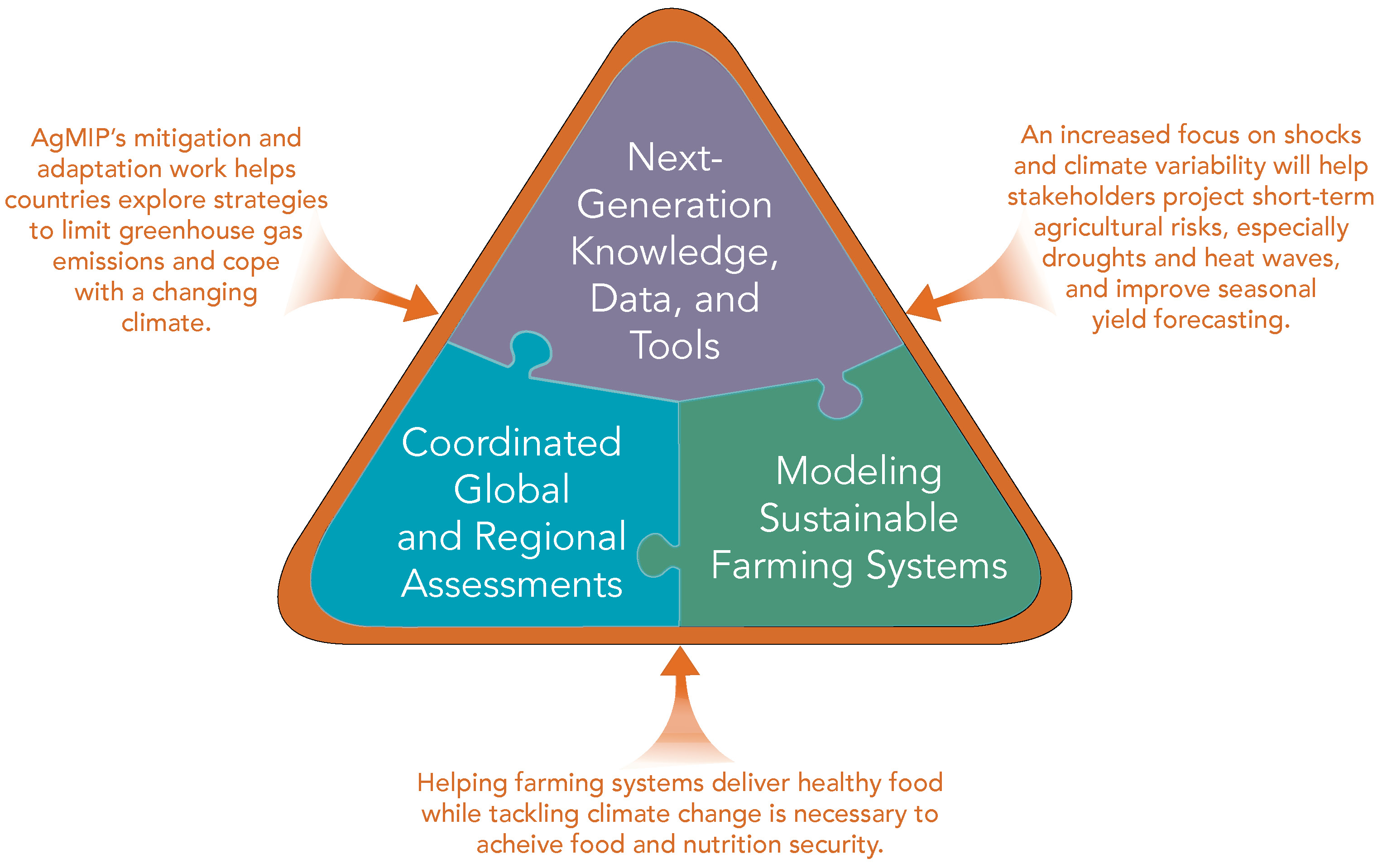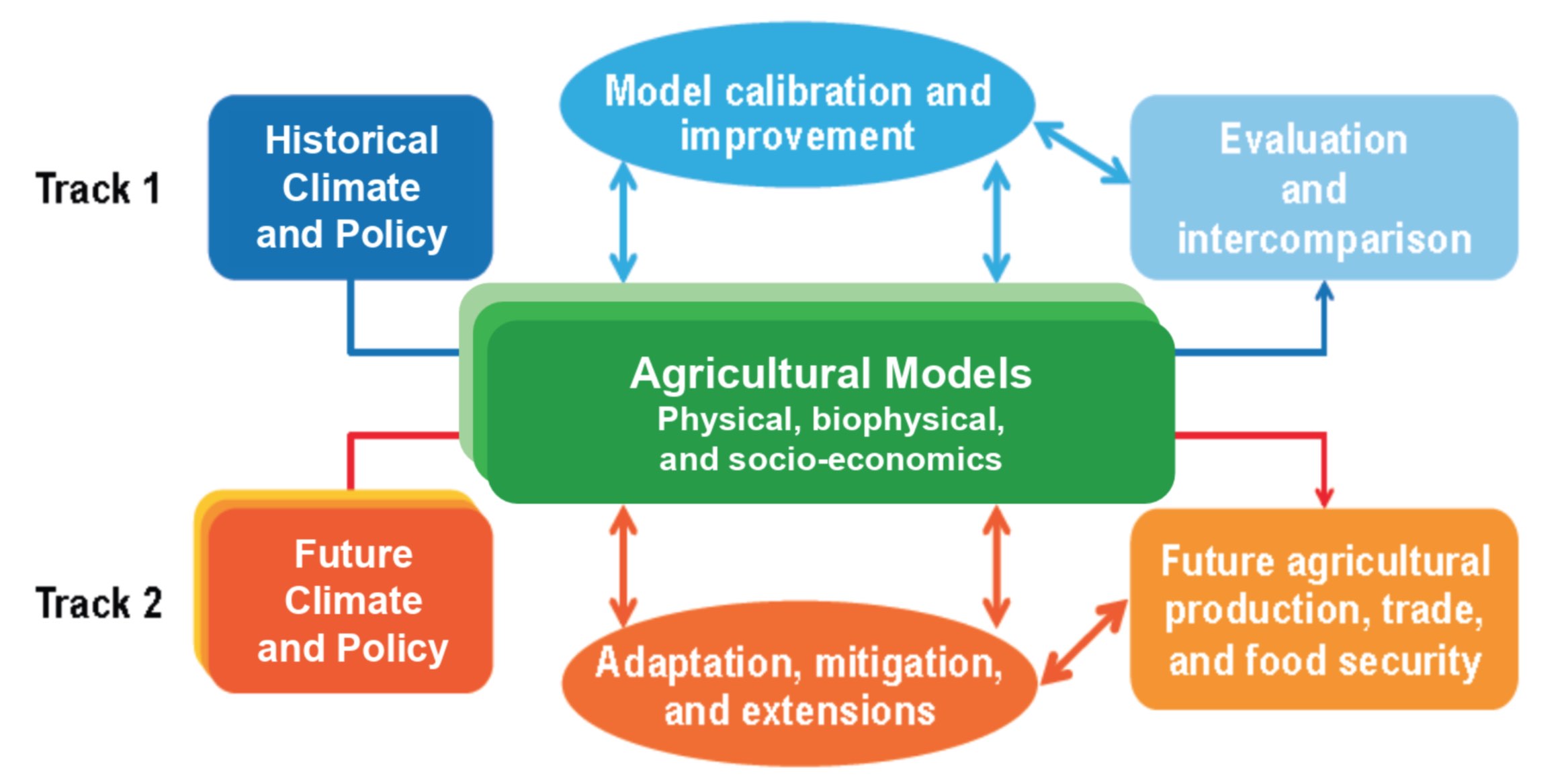Approach
The Agricultural Model Intercomparison and Improvement Project (AgMIP) was created in 2010 to provide a community for systematic improvement and application of multi-disciplinary, multi-model, multi-scale frameworks for agricultural development and food security. AgMIP research aims to substantially advance our understanding of model strengths, weaknesses, and uncertainty while also developing new approaches including data integration and transdisciplinary modeling frameworks. In 2015, AgMIP committed to advance research to enable transdiciplinary outcomes in three overlapping areas, or pillars. These include: Coordinated Global and Regional Assessments, Next Generation Knowledge, Data and Tools, and Modeling Sustainable Farming Systems.
AgMIP Pillars
Coordinated Global and Regional Assessments
CGRA uses a multi-model, multi-scale, multi-disciplinary, and multi-method framework to explore adaptation, mitigation, food policy, and food security in the face of an uncertain future.
Next-Generation Knowledge, Data, and Tools
Agricultural data stewardship and advanced tools are needed to enable sustainable production that can meet future national and international food, fiber, and bioenergy needs.
Modeling Sustainable Farming Systems
Sustainable farming systems is about assessing water; land; climate extremes and carbon-smart economically viable agricultural practices in a changing world.

AgMIP’s linked pillars and driving motivations
AgMIP Two-Track Science Approach
AgMIP bases its research and application activities on systematic, protocol-based assessments that consistently connect biophysical and socioeconomic aspects of agriculture and the food system, recognizing that agricultural stakeholders create productive biological systems within complex environments and socioeconomic contexts. AgMIP’s 30+ research activities follow a two-track science approach to ensure a strong foundation of historical data and model understanding underpinning assessments of alternative climate, policies, or agricultural system interventions anticipated for the future. AgMIP’s use of multiple models and transdisciplinary frameworks allow for more rigorous science-based evidence for stakeholder actions by incorporating a broader representation of key scientific advances and enabling the beneficial use of ensemble statistics while also facilitating community learning and model improvement.

Modified from Rosenzweig et al., 2013 Agricultural and Forest Meteorology
AgMIP’s two-track science and application approach ensures strong configuration, intercomparison, and cutting-edge advancement of linked agricultural models and then applies the robust modeling framework to evaluate alternative climate and policy futures.
Track 1: Model Application Improvement
The credibility of agricultural modeling applications depends on demonstrated responses to observed conditions and a careful evaluation against observed data, so AgMIP Track 1 drives agricultural models with historical climate and policy in order to evaluate stakeholder-relevant outputs and system responses against, identify model differences, and improve model configuration. AgMIP has developed several approaches to generate historical climate-forcing datasets that can drive model simulations aiming to capture prominent features of high- and low-producing seasons as well as assess the long-term sustainability of farm systems. Track 1 historical evaluations challenge the models to reproduce observed growth, respond to stresses, and track the socioeconomic ramifications of production anomalies (which are also shaped by policy factors such as subsidies, taxes, the promotion of technological interventions, and pressures from beyond the agricultural sector). Track 1 also points towards improvements that would increase models’ ability to reproduce observed outcomes, including by developing more accurate simulation of key processes (such as heat and water stress affecting different growth stages) or more properly configuring farm systems (characteristics such as soils, field management, genetics, household expenses). The AgMIP community also strives to build and extend capacity for model development and application to science and stakeholder communities around the world.
Track 2: Climate Change Multi-Model Assessment
AgMIP Track 2 assessments utilize the configured models (from Track 1) to assess alternative agricultural systems that may be implemented under future climate or policy contexts. As there is always a degree of uncertainty around future conditions, AgMIP utilizes multiple scenarios and models to assess and probabilistically manage risk. Key to this is sustained engagement with stakeholders to co-develop representative agricultural pathways (RAPs) that allow simulations to represent key background attributes of future agricultural systems across scales (including prices, subsidies, taxes, market development, technological shifts, socioeconomic development). Track 2 model-based applications allow for an assessment of agricultural production, trade, and food security under conditions that have not been observed, allowing stakeholders to explore strategies for adaptation and mitigation interventions that may be iteratively assessed to improve desired outcomes. Under Track 2 the models themselves are not changed (and are thus consistent with Track 1 evaluations), but the configurations may be altered to represent adaptation responses (such as changing planting dates, cultivars, land-use, equipment purchases, market access, risk transfer mechanisms) and mitigation responses (such as carbon sequestration, land-use change, the use of alternative crop species). Track 2 outputs are also of broader interest to the science and decision-making communities, so AgMIP stores key agricultural variables to extended applications related to sustainable resource use (water, land, energy, carbon, labor), models of extended agricultural systems (irrigation systems, pests and diseases), and linked societal sector applications (water resources, cities, ecosystems, energy, industry, infrastructure).
